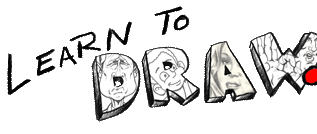|
As you turn your head from a profile view to looking
straight at the artist, the placement of the various
facial elements on your head doesn't change. So many of
the measurements and proportions you saw in profiles are
still true in straight on drawings. Your eyes are still
at the halfway point on your head, so drawing an "eyeline"
is still helpful in placing facial elements.
 You
can start your drawing in much the same way as a profile
by drawing an egg shape and bisecting it with an eye
line through it's horizontal midpoint. The egg you'd
sketch in for a straight on portrait would look like an
egg that would appear upside down - with the narrower
portion of the shape at the bottom. In addition to
bisecting the egg at it's horizontal midpoint, bisect it
with a vertical line down the middle. This will help you
correctly place the nose. You
can start your drawing in much the same way as a profile
by drawing an egg shape and bisecting it with an eye
line through it's horizontal midpoint. The egg you'd
sketch in for a straight on portrait would look like an
egg that would appear upside down - with the narrower
portion of the shape at the bottom. In addition to
bisecting the egg at it's horizontal midpoint, bisect it
with a vertical line down the middle. This will help you
correctly place the nose.
The basic unit many artists use in portraiture is the
length of the eye. This is probably because it's one of
the first things drawn, and it's also a nice
medium-sized element on the face. For me, it's because
the right eye is almost always the first thing I draw,
and then the first measurement I take is the space
between the eyes - which is one eye. There's your first
common measurement. As with all "global" measurements,
measure them on your subject to make sure it's true -
not all people have exactly one eye length between their
eyes. Also, the eyes usually are horizontally aligned,
but not always. Looking at the two tear ducts to see if
they are on the same horizontal plane is an easy way to
see if the eyes are aligned.
So, in most cases, there is one "eye" measurement
between the eyes, what else? Almost the entire face and
it's features can be measured using the eye. When
measuring, first compare the eye with another facial
feature on your subject, then measure your drawn eye and
measure out the feature you'll be drawing. After you
have drawn and correctly spaced the two eyes of your
subject, here are the measurements you can take...
 Measure
the right eye with your pencil by placing the tip of
your pencil at the outside corner of the eye, then place
your index finger at the tear duct. Hold that
measurement, and at the tear duct, turn the pencil 90
degrees down, you're measuring for the length of the
nose. On many people the nose is one eye, or one and a
half eyes long. This will get the vertical placement of
the nose. Measure
the right eye with your pencil by placing the tip of
your pencil at the outside corner of the eye, then place
your index finger at the tear duct. Hold that
measurement, and at the tear duct, turn the pencil 90
degrees down, you're measuring for the length of the
nose. On many people the nose is one eye, or one and a
half eyes long. This will get the vertical placement of
the nose.
 Gauge
the horizontal placement of the nose by placing your
pencil vertically on one edge of a nose lobe. Note where
the lobe will line up on the eye above. Right at the
tear duct, usually, but not always. Use the same
vertical measure on the other nose lobe and DO NOT
assume that the placement will be the same as the other
lobe. On the bearded guy to the right, notice that his
left lobe is a tad bit larger than his right one, but
his nose looks pretty centered on his face. This shows
that the ball of his nose points a bit to the right, his
nose isn't straight. Note this kind of stuff when you're
drawing portraits. Gauge
the horizontal placement of the nose by placing your
pencil vertically on one edge of a nose lobe. Note where
the lobe will line up on the eye above. Right at the
tear duct, usually, but not always. Use the same
vertical measure on the other nose lobe and DO NOT
assume that the placement will be the same as the other
lobe. On the bearded guy to the right, notice that his
left lobe is a tad bit larger than his right one, but
his nose looks pretty centered on his face. This shows
that the ball of his nose points a bit to the right, his
nose isn't straight. Note this kind of stuff when you're
drawing portraits.
 After
getting the placement of the nose, measure the width of
the nose. Often the nose is one eye wide. After
getting the placement of the nose, measure the width of
the nose. Often the nose is one eye wide.
 The
space between the nose and upper lip is often half an
eye. This will help to get the vertical placement of the
mouth. The
space between the nose and upper lip is often half an
eye. This will help to get the vertical placement of the
mouth. |
